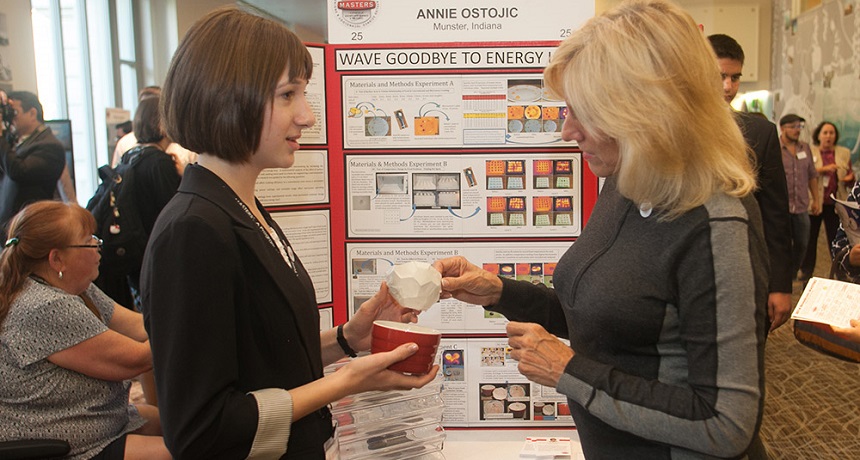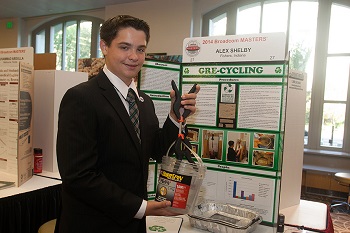Food can make an appetizing science fair project
Broadcom MASTERS finalists show that a good experiment could start at the dinner table

Annie Ostojic shows off her half soccer ball in a cup. It’s a solution she designed to heat food more evenly in a microwave oven.
L. Doane/SSP
WASHINGTON — People ask plenty of questions about their food, and many don’t just stop at “what’s in this?” At this year’s Broadcom MASTERS (Math, Applied Science, Technology and Engineering for Rising Stars) competition in Washington, D.C., last month, many finalists showed off food-based projects. Their findings could change how people heat leftovers, where they go fishing and even how they recycle pizza boxes.
Broadcom MASTERS brings together 30 students to share their winning middle-school science-fair projects and compete in a series of group research events. The participants not only have fun and make friends, but also can take home big prize money. The top award: $25,000. The competition was created by the Society for Science & the Public. It’s sponsored by Broadcom, a company that creates many of the Internet-connecting devices you use every day in your smartphone or computer.
Food projects are tasty options for science competitions. They can be relatively cheap. “You could probably do my project with a little more money than your allowance,” says Annie Ostojic, 12. She’s a Broadcom MASTERS finalist from Wilbur Wright Middle School in Munster, Ind. She purchased all of the supplies for her experiments at the grocery store. Annie used cubes of cheese, potatoes, rice and marshmallows to find the hot spots in her parents’ microwave oven. She also studied how a food’s size and shape can affect the speed at which foods heat up in a microwave or standard oven.
Alex Shelby, 14, also found he didn’t need a fancy lab to study food — and its packaging. He wanted to learn how grease could be removed from pizza boxes so that recyclers would reuse the cardboard. Right now, they ignore this potential resource because the grease would weaken any recycled cardboard made from the boxes. Alex says many people sneak try to recycle pizza boxes anyway. They are unaware of the problems this can cause. The pizza grease can ruin recycled materials. Sneaking pizza boxes into the recycling can cost recycling companies a lot of money.

“It was easy to do,” he says. “I could easily find out how to recycle cardboard. And I could do it myself at home.” Alex also notes that the pizza grease problem was right under his nose. “There was a problem already posed to me,” he explains. “I just had to come up with the answer.” The teen was able to show that one dishwashing detergent was best for removing grease from a cardboard mixture. Using it resulted in stronger recycled cardboard.
A matter of taste
Food projects aren’t just limited to the food we put in our microwaves or pizza boxes. Biology projects are basically about the acquisition of food, says James Roney, 14. “It’s one of those things that every organism needs.”
This teen is now a freshman at Dos Pueblos High School in Goleta, Calif. But last year, he used his middle-school science-fair project to study how ants share information on their food sources. Ants lay down trails of chemical signals, called pheromones (FAIR-ah-moanz). He showed these signals communicate not only where the food is, but also whether it’s a high quality food. With some modeling clay, tiny plastic lids for disposable cups, drinking straws and sugar water, James showed that the ants in his garage relayed information about the sweetest water to the other members of their colony. More ants ended up marching toward the solutions with the most sugar. Relatively few ants trudged toward the not-so-sweet mixtures.
Studying what other animals rely on for food can point to the role of pollution in our environment. In 2010, for instance, an explosion sunk the Deepwater Horizon oil-drilling platform. Afterwards, the drilling pipe leaked millions of barrels of oil into the Gulf of Mexico. Joshua Courtney, then at Carmel Hill School in Baton Rouge, La., watched as the local oystermen moved into the nearby brackish Calcasieu Lake. The lake is right up against the Gulf of Mexico. It’s an estuary, a place where fresh and salt water meet. It had a vibrant oyster population in 2010, when oyster fisherman moved in. But Joshua began to wonder what would happen to the fish in the estuary that might depend on the oysters for food, now that their oyster buffet was being fished away.
To find out, he measured the length and weight of four different species of fish. He charted these data for more than 700 fish that fishermen pulled from the lake over three years. Black drum (Pogonias cromis) and gafftopsail catfish (Bagre marinus) were skinnier after the fishermen began harvesting the food — oysters — on which the drum and catfish feed. In contrast, two species that fed on other prey — the spotted sea trout (Cynoscion nebulosus) and the red drum (Sciaenops ocellatus) — were relatively fine and fat.“The way to fix this is to let the number of oysters grow,” he concludes.
Small experiments, big impacts
Some food studies don’t cost a lot or require a big lab, but still may yield important data. That’s what Gelsey Jaymes, 12, found. A student at Porter-Gaud School in Mt. Pleasant, S.C., she studied how the increasing acidity of ocean water might affect the oysters she loves to eat.
Burning fossil fuels, such as coal, releases carbon dioxide into the air. This gas helps trap heat close to Earth’s surface, warming the planet. But the oceans absorb carbon dioxide too. And Gelsey wanted to understand what impact that might have. So she dissolved different concentrations of carbon dioxide into seawater, creating carbonic acid. Then she popped oyster shells into the water and recorded what happened.
As the acidity increased, it ate away at the oyster shells. Thinner shells mean vulnerable oysters. Gelsey used acid concentrations in the water that represent concentrations that scientists predict will occur as Earth warms. “Most people don’t realize that carbon dioxide doesn’t just affect the atmosphere,” Gelsey says. Some also “dissolves into the water and becomes carbonic acid,” she says, “which can harm the oysters.”
Annie used her results to build a new container to more effectively reheat foods in a microwave oven. It’s shaped like half a soccer ball. A cook fills this bowl with food and inserted into a larger bowl with water at the bottom. This creates something called a double-boiler. When the microwave is turned on, the energy in the microwave heats the water at the bottom of the bowl to produce steam. The steam heats the half –ball-shaped container from the bottom. This helps to heat the food throughout the container more evenly. She hopes that her studies of microwave ovens will help people heat their food better.
Her own unpleasant experience of being served food that left the microwave oven half-heated inspired her research. “It’s a common issue that people go through,” she notes.
Studying food also can affect what other people eat, notes Linus Freyer, 13. His family was living in Germany during a scandal over processed foods, such as the mystery meat found in frozen lasagnas. The European Union found that many processed meats did not just contain beef, pork or chicken: Some also contained horse. That hadn’t been listed on the labels. When Linus moved to the United States, he wanted to see if American food might have similar meat-labeling problems.
Linus analyzed the DNA — the genetic material present in the cells that make up meat — to identify what species had been used in eight different frozen lasagnas made with meat sauce. The teen, now at Coral Reef Senior High School in Pinecrest, Fla., showed three brands labeled as “all beef” lasagnas were mislabeled. All the samples contained beef, but these three also contained some pork or chicken (notably, none contained horse). Linus says his results are very important because some cultures and religions do not eat beef or pork. “I think you should respect that,” he says.
Whether the impacts are big or small, studying food can be a great science fair project. “You can always be sure to find something surprising,” Linus says.
Follow Eureka! Lab on Twitter
Power Words
carbon dioxide A colorless, odorless gas produced by all animals when the oxygen they inhale reacts with the carbon-rich foods that they’ve eaten. Carbon dioxide also is released when organic matter (including fossil fuels like oil or gas) is burned. Carbon dioxide acts as a greenhouse gas, trapping heat in Earth’s atmosphere. Plants convert carbon dioxide into oxygen during photosynthesis, the process they use to make their own food.
carbonic acid A solution of carbon dioxide in water.
climate The weather conditions prevailing in an area in general or over a long period.
climate change Long-term, significant change in the climate of Earth. It can happen naturally or in response to human activities, including the burning of fossil fuels and clearing of forests.
dissolution A process in which a solid forms a solution with a liquid.
DNA (short for deoxyribonucleic acid) A long, double-stranded and spiral-shaped molecule inside most living cells that carries genetic instructions. In all living things, from plants and animals to microbes, these instructions tell cells which molecules to make.
global warming The gradual increase in the overall temperature of Earth’s atmosphere due to the greenhouse effect. This effect is caused by increased levels of carbon dioxide, chlorofluorocarbons and other gases in the air, many of them released by human activity.
organism Any living thing, from elephants and plants to bacteria and other types of single-celled life.
pheromone A molecule or specific mix of molecules that makes other members of the same species change their behavior or development.Pheromones drift through the air and send messages to other animals, saying such things as “danger” or “I’m looking for a mate.”
recycle To find new uses for something — or parts of something — that might otherwise by discarded, or treated as waste.